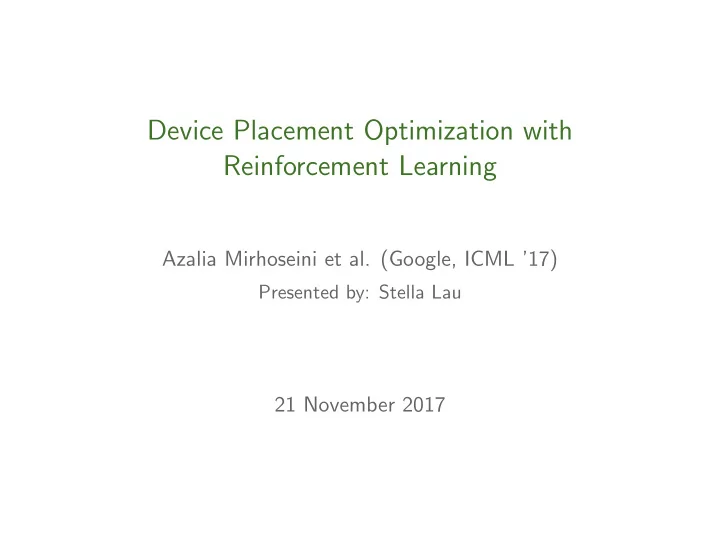

Device Placement Optimization with Reinforcement Learning Azalia Mirhoseini et al. (Google, ICML ’17) Presented by: Stella Lau 21 November 2017
Motivation Problem Neural networks are large ⇒ heterogeneous environment Which operations go on which CPUs/GPUs?
Motivation Problem Neural networks are large ⇒ heterogeneous environment Which operations go on which CPUs/GPUs? Solution Expert manually specifies device placement? • It’s manual. . . Use reinforcement learning
Contributions A reinforcement learning approach for device placement optimization in TensorFlow graphs. • Manually assigning variables and operations in a distributed TensorFlow environment is annoying • https://github.com/tensorflow/tensorflow/issues/2126 • Reward signal: execution time
Device placement optimization • TensorFlow graph G : M operations { o 1 , . . . , o M } , list of D devices • Placement P : assign each operation o i to a device p i ∈ D • r ( P ): execution time of placement • Device placement optimization: find P such that r ( P ) is minimized
Architecture overview Sequence-to-sequence model with LSTM and a content-based attention mechanism 1. Encoder RNN: ◮ input = op i embedded in (type, output shape, adj) 2. Decoder RNN: attentional LSTM with fixed number of time steps equal to number of operations ◮ Decoder outputs device for operation at same encoder step ◮ Each device has own tunable embedding, fed to next step
Challenges overview 1. Training with noisy policy gradients 2. Thousands of operations in TensorFlow graphs 3. Long training time
Challenge I: Training with noisy policy gradients Problem 1. Noisy r ( P ) especially at start (bad placements) 2. Placements converge ⇒ indistinguishable training signals
Challenge I: Training with noisy policy gradients Problem 1. Noisy r ( P ) especially at start (bad placements) 2. Placements converge ⇒ indistinguishable training signals Solution � • Empirical finding: use R ( P ) = r ( P • Stochastic policy π ( P|G ; θ ): minimize J ( θ ) = E P ∼ π ( P|G ; θ ) [ R ( P ) |G ] • Train with policy gradients: reduce variance with baseline � K • ∇ θ J ( θ ) ≈ 1 i =1 ( R ( P i ) − B ) · ∇ θ log p ( P i |G ; θ ) K • Some placements fail to execute ⇒ specify failing signal • Some placements randomly fail: bad at end ⇒ after 5000 steps, update parameters only if placement executes
Challenge II: Thousands of operations in TensorFlow graphs Model #operations #groups RNNLM 8943 188 NMT 22097 280 Inception-V3 31180 83 Co-location groups: manually force several operations to be on the same device Heuristics: 1. Default TensorFlow co-location groups: co-locate each operation’s outputs with its gradients 2. If output of op X is consumed only by op Y , co-locate X and Y (recursive procedure, especially useful for initialization) 3. Model-specific rules: e.g. with RNN models, treat each LSTM cell as a group
Challenge III: Long training time Use asynchronous distributed training to speed up training
Challenge III: Long training time Use asynchronous distributed training to speed up training • K workers per controller, K is number of placement samples • Phase I: workers receive signal to wait for placements, controller receives signal to sample K placements • Phase II: Worker executes placement, measures run time. Executed for 10 steps, average run time except first • 20 controller, with 4-8 workers ⇒ 12-27 hours training • More workers = more accurate estimates, more idle workers • Each controller has own baseline
Benchmarks: three models 1. RNNLM: Recurrent Neural Network Language Model ◮ grid structure; very parallelisable 2. NMT: Neural Machine Translation ◮ LSTM layer, softmax layer, attention layer 3. Inception-V3: imagine recognition and visual feature extraction; ◮ multiple blocks; branches of convolutional and pooling layers; more restricted parallelisation Pre-processed with co-location groups
Single step run times • RNNLM: fit entire graph into one GPU to reduce inter-device communication latencies • NMT: non-trivial placement. Use 4 GPUs, put less computationally expensive operations on CPU • Inception-V3: use 4 GPUs; baselines assign all operations to a single GPU
Other contributions • Reduced training time to reach the same level of accuracy • Analysis of reinforcement learning based placements versus expert placements ◮ NMT: RL approach balances workload better ◮ Inception-V3: less balanced because less room for parallelism
Related work • Neural networks and reinforcement learning for combinatorial optimization ◮ Novelty: large-scale applications with noisy rewards • Reinforcement learning to optimize system performance • Graph partitioning ◮ Graph partitioning algorithms are only heuristics: cost models need to be constructed (hard to estimate, not accurate) ◮ Scotch optimizer: balance tasks among set of connected nodes, reducing communication costs
Summary and comments A reinforcement learning approach to device placement optimization in TensorFlow Questions? • Only execution time is used as a metric. What about memory? • Device placement optimization is still time consuming (20 hours with 80 GPUs?) • Limited detail on training procedure and architecture • Limited discussion on directions for future work
Recommend
More recommend